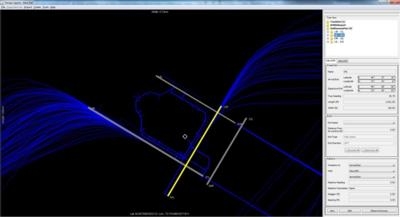Sat, Jan 03, 2015
Software Simulates Arriving And Departing Traffic To Assist In Runway Assignments And Sequencing
For several years, the FAA has used the results of an airport capacity tool called the runwaySimulator model that was developed by MITRE to efficiently evaluate an airport’s capacity.

The tool is now being made publicly available to those with interests in aviation and airport planning. The tool can be used to assess an airport’s existing capacity, as well as capacity improvements with new infrastructure or flight procedures.
The runwaySimulator model simulates arriving and departing traffic at an airport, the decisions made about runway assignment and sequencing, and the flight operations themselves. The model generates a randomized traffic sample that keeps pressure on the airport. The traffic sample reflects an airport's mix of aircraft types, which differ in their performance parameters.
FAA separation standards are codified in the software as rules that govern pairs of flight operations, and these are modified to represent common pilot and controller behaviors. The runway configuration is set and exceptions noted to prohibit use of specified runways by certain aircraft types or to set aside runways for exclusive use by, say, general aviation traffic. A heuristic algorithm assigns runways and sequences traffic to balance efficiency and delay while respecting separation requirements and runway eligibilities.
When used to estimate capacity, runwaySimulator generates traffic so there is constant demand on the runway system. It does this for various arrival-departure mixes and, for each, simulates steady-state operations for several hundred hours. The average throughput achieved is recorded for each arrival-departure mix and used to create the airport's capacity "curve" (i.e., a Pareto frontier). The model provides a variety of measurements and visualizations to the analyst to verify and validate the simulation.
The tool can be used to estimate runway capacity with current and future operations. However, runwaySimulator does not evaluate most non-runway constraints at the airport nor limitations elsewhere in the national airspace system. Such constraints may include taxiway or gate constrains, terminal airspace congestion, Air Traffic Control traffic management initiatives, and seasonal limitations due to high temperatures that restrict aircraft climb rates.
(Runway simulator screenshot provided by the FAA)
More News
Terminal Radar Service Area Airspace surrounding designated airports wherein ATC provides radar vectoring, sequencing, and separation on a full-time basis for all IFR and participa>[...]
Aero Linx: Utah Back Country Pilots Association (UBCP) Through the sharing experiences, the UBCP has built upon a foundation of safe operating practices in some of the most challen>[...]
From 2010 (YouTube Edition): Imagine... Be The Change... Inspire FROM 2010: One of the more unusual phone calls I have ever received occurred a few years ago... from Anousheh Ansar>[...]
(Pilot) Felt A Shudder And Heard The Engine Sounding Differently, Followed By The Engine Chip Detector Light On April 14, 2025, about 1800 Pacific daylight time, a Bell 206B, N1667>[...]
Also: AMA Names Tyler Dobbs, More Falcon 9 Ops, Firefly Launch Unsuccessful, Autonomous F-16s The Air Force has begun ground testing a future uncrewed jet design in a milestone tow>[...]
 ANN's Daily Aero-Term (05.07.25): Terminal Radar Service Area
ANN's Daily Aero-Term (05.07.25): Terminal Radar Service Area ANN's Daily Aero-Linx (05.07.25)
ANN's Daily Aero-Linx (05.07.25) Classic Aero-TV: Anousheh Ansari -- The Woman Behind The Prize
Classic Aero-TV: Anousheh Ansari -- The Woman Behind The Prize NTSB Prelim: Bell 206B
NTSB Prelim: Bell 206B Airborne-NextGen 05.06.25: AF Uncrewed Fighters, Drones v Planes, Joby Crew Test
Airborne-NextGen 05.06.25: AF Uncrewed Fighters, Drones v Planes, Joby Crew Test



